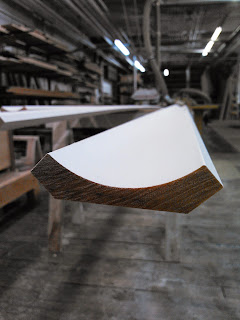This was what I was hired to replace: One Stove Vent
I met with this couple to replace two simple things around the exterior of the home. Two vents, one dryer vent and one stove vent. I gave them a price and once I made my way toward replacing the stove vent, I knew it was going to have other issues just by the looks of it. The vent was causing water issues years ago (I was not told this before starting) and the home is 19 years old. This vent was installed by the contractor that built the home and the homeowner ended up having to caulk around that vent years later because it was only screwed. No flashing, no j-channel, no redundancy.
 |
| Looks pretty moist in there! |
 |
| Mold |
 |
| Caulking under the siding |
In these photos its hard to see but the first course of vinyl was caulked to the foundation. Now this would not be an issue if only a little water came in once a year on a freak driving rain. BUT this wall had bulk water coming in with no way out at the bottom.
 |
| The resulting damage! |

Typically, water inside the building envelope provides a source of water for insects so they don't have to leave to grab a drink. Additionally inside their warm, wet home they can dip inside your home for a little sugar snack every now and then too without the colony being discovered. In this case
carpenter ants would come in and graze the counters in small numbers whenever the homeowners would cook. They hired me for a vent and I opened a wall of ants on them!

The drywall was intact thanks too the insulation keeping the water off the drywall and so you can see here how I removed all rotten and moist wood from the wall and re-framed the wall with fresh studs and insulation.
 |
| Blocks to strengthen the cut on both sides of the stud. |
 |
| Sheathing on top of the frost wall |
The original wall sheathing was installed RIGHT on top of the foundation wall and as you can see the homes structure settled and shrunk and the engineered plywood didn't. So it happened to bulge out right down at the base of the wall.
Through the last and final restore steps, I did not manage to take any photos of the metal bending or the roofing application because this whole job was unexpected and a priority once it was discovered so I had to act fast in order to not push my scheduled jobs back too far. This took three days.

In this photo to the right, their is now kick-out flashing on the roof/ exterior wall. This flashing detail is CRUCIAL!! Bulk was travels down the roof and siding inside the channel of vinyl that goes down the roof. Half of all that water over 19+ years was going behind the siding and down over the sheathing. Now at the end of the channel it is deterred (kicked out) from the channel and into the gutter!
All because of one terribly flashed stove vent and a lack of flashing on the wall to kick water away. The gutter was somewhat clogged too so that was another contributor to the damage but the lack of kick-out flashing was the biggest one. Also don't caulk vinyl siding to the foundation.
Kick-out your bulk water and install your stove vents properly... or this could be your house.
 In this photo, and it is not quite clear, but that darker flooring is the older yellow pine and you can clearly see the new stuff unfinished. Here I am working my way down the hallway to reach the bedrooms.
In this photo, and it is not quite clear, but that darker flooring is the older yellow pine and you can clearly see the new stuff unfinished. Here I am working my way down the hallway to reach the bedrooms. 
































































